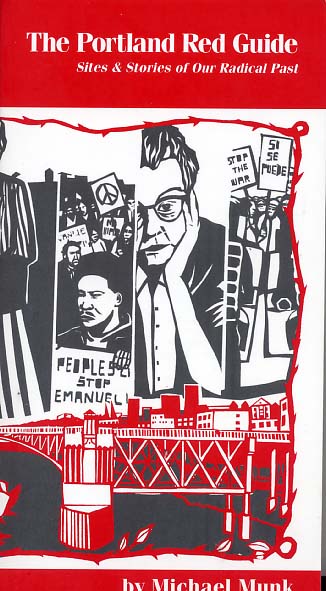Welcome back to Thomas Lauderdale’s Summer Reading List! This week’s selection is another nonfiction book all about our beloved hometown. The Portland Red Guide: Sites and Stories of Our Radical Past by Michael Munk is full of fascinating facts all about the history of social dissent in Portland, linking local radicals, organizations, and their activities to physical sites in the city. But enough from us — take it away, Thomas!
 “I love this book! It has maps! It has pictures! it talks about how crazy and wonderful the history of Portland is. Whether it’s Emma Goldman—the pioneering lesbian and feminist–giving a lecture on lesbianism in 1915, two blocks away from my house at the Portland auditorium and getting arrested and hauled off to jail—to Woodie Guthrie living on SE 92 in the summer of 1941 and writing all the songs for the Bonneville Power Administration, to the internment of Japanese-Americans during the war. It also talks about writers like John Reed, the Oregonian journalist who is buried in Red Square:
“I love this book! It has maps! It has pictures! it talks about how crazy and wonderful the history of Portland is. Whether it’s Emma Goldman—the pioneering lesbian and feminist–giving a lecture on lesbianism in 1915, two blocks away from my house at the Portland auditorium and getting arrested and hauled off to jail—to Woodie Guthrie living on SE 92 in the summer of 1941 and writing all the songs for the Bonneville Power Administration, to the internment of Japanese-Americans during the war. It also talks about writers like John Reed, the Oregonian journalist who is buried in Red Square:
Probably the best known of Portland radicals is the writer, poet, and revolutionary John Reed (1886-1920). All that remains of the big house on the hill above the city where he was born are the steps linking the end of SW Cedar Street with the end of SW Cactus Drive. He remembered Cedar Hill as a ‘lordly grey mansion modeled on a French chateau, with its immense park, its formal gardens, lawns, stables, greenhouses, and glass grape arbor, the tame deer among the trees.’ Reed’s first published work was featured in the May 1902 issue of The Troubadour, the student literary magazine of his private high school, the Portland Academy. The final stanza of the poem describes the eighteenth century eruption of Mt. St. Helens and its impact on the Columbia River, written when Jack Reed (as he signed himself) was fifteen years old.
Home for the summer of 1909 from Harvard, a sarcastic Reed wrote a girlfriend asking if ‘Portland [was] still the same giddy bewildering place that [made] people leave New York in the gay season and come out here for fun.’ […] On his last visit to his hometown in December 1915, Reed found it ‘awful beyond words…I don’t feel I can talk to a single person here.’ Reed died of typhus in the Soviet Union after publishing Ten Days That Shook the World and remains buried in the revolutionaries’ cemetery at the walls of the Kremlin.
Isn’t that awesome? Here’s another — Beatrice Morrow Cannady.
A few years after Beatrice Morrow Cannady arrived in Portland in 1912, she organized one of the city’s first interracial protest events; a movement to ban the nation’s favorite, but racist, Ku Klux Klan recruiting film, Birth of a Nation. Enthusiastically endorsed by President Woodrow Wilson, the silent movie was credited with helping the Oregon Klan grow into a major political force. When it was shown at the singularly named Blue Mouse Theater at SW 11th Avenue and Washington Street, its owner John Hamrick used the occasion to announce his Klan membership. According to Portland civil rights activist Bobbie Nunn, the film was eventually banned in Portland in the 1950s after an effort headed by the National Association for the Advancement of Colored People (NAACP) and the Urban League.
Beatrice moved to Portland to marry Edward D. Cannady and to work with him on the four-page weekly, Advocate, which Cannady founded in 1903 with other Portland Hotel employees. The Cannadys and their two sons lived at 2516 NE 26th Avenue. Beatrice became secretary of the new NAACP, organized in 1913 (the oldest continuously organized chapter west of the Mississippi) and fought discrimination and segregation I the community and the courts. In 1922, she became the first black woman to graduate from law school, attending night classes at the Northwest College of Law. Although she represented clients in court, she did not pass the Oregon Bar examination. After failing to be elected to the state legislature, she left Portland for good in 1936 and lived in California for the rest of her life.
It really makes you think about time and progress. Where will we be in 50 years? What progress do we not even realize we need to make? That’s why I still want to run for office and fix some stuff. There’s still so much left to be done here.”
Interested in reading The Portland Red Guide: Sites and Stories of Our Radical Past? Visit www.powells.com to pick up your copy today. And make sure you come back next week for the next installment of Thomas Lauderdale’s Summer Reading List!





